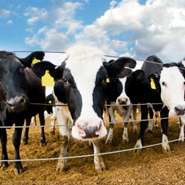Tail hair tells tale of cattle’s diet -- Scientists trace grassland production

Tail hair can show if cattle have been grass-fed or not, according to scientists. By chemically analysing the tail hair, it is also possible for scientists to tell if, and when, a grass diet has been substituted for other types of feed over the past 12 months.
The findings published in the Journal of Agricultural and Food Chemistry show a clear scientific traceability and verification of grassland production.
“We can no longer depend on paperwork alone to trace production methods or feeds given to farm animals,” says Professor Frank Monahan from the UCD School of Agriculture, Food Science, and Veterinary Medicine at University College Dublin, and the UCD Institute of Food and Health, the first author of the scientific study.
“A tail hair of approximately 30 centimetres in length contains over a year’s information on the animal’s diet, with the hair closest to the skin holding clues to the most recent diet,” he explains.
“By plucking a hair from the tail, cutting it into millimetre segments, and analysing these in sequence we can get information about the diet over the previous days, weeks and months and, importantly, when the diet was changed,” explains Professor Monahan.
The method involves combusting the tail hair and measuring the isotopes of hydrogen, carbon, nitrogen and sulphur emitted.
Following the analysis, the scientists can almost identify the precise day when the grass diet of the animal may have been substituted with cereal or concentrate.
According to the scientists, omega 3 fatty acids are significantly higher in grass-fed beef than they are in cereal-fed beef. As a result, beef from grass-fed cattle is often labelled and marketed on the basis of having high levels of omega 3 fatty acids and CLA (which together have been linked to several health benefits in humans).
“Consumers are increasingly interested in the origin and authenticity of the food they consume. So there is a clear need for reliable methods to verify the dietary history of farm animals,” says Dr. Aidan Moloney from the Animal and Grassland Research and Innovation Centre at Teagasc, the Irish Agriculture and Food Development Authority, who co-authored the study.
In the US food labels identifying if a farm animal has been ‘grass-fed’ allows for a premium to be charged for the product.
The scientists believe that a similar labelling could help the Irish beef industry to introduce a premium for its products.
The research was funded by the Irish Government’s Department of Agriculture, Fisheries and Food.
In 2006, US scientists used a similar method of chemically analysing tail hair to track the movement of elephants in Kenya. The aim was to help conservationists decide where to locate Elephant sanctuaries. The analysis showed that some elephants in the sanctuaries had raided nearby crop fields for food, a cause for concern among the local populations.
More information: 'Beef authentication and retrospective dietary verification using stable isotope ratio analysis of bovine muscle and tail hair.' Osorio, M.T, et al. (2011) Journal of Agricultural and Food Chemistry, 59 (7), pp 3295–3305
Provided by University College Dublin

















